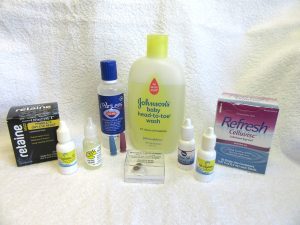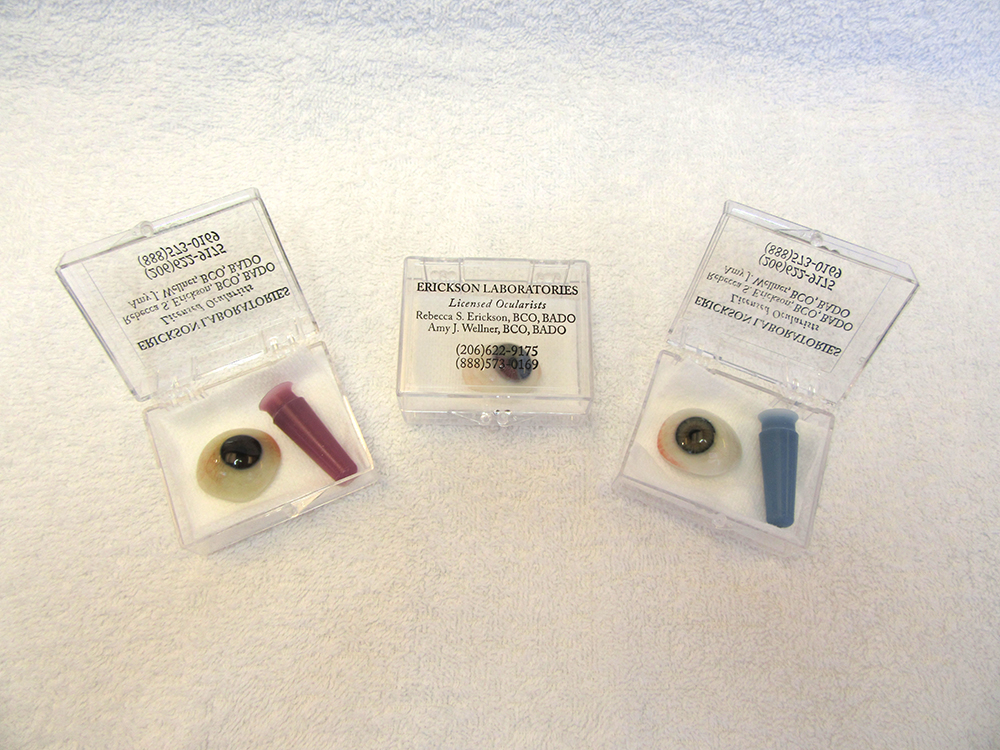Always use clean hands and good hygiene when handling conformers, prosthetic eyes or scleral cover shells. Your tears should function to keep the prosthesis clean, like they do in a healthy functioning eye.
Generally we recommend to remove your ocular prosthesis only as necessary to clean, or as often as decided by your Ocularist at Erickson Laboratories. Too much handling can cause socket irritation and result in excessive secretions. (*This may not pertain to Scleral Cover shell patients who may remove the prosthesis while sleeping.) Use only water that is free from impurities. Do not use Alcohol or other products on or around the ocular prosthesis, as they could be harmful to the prosthesis!
An easy and soothing way to clean your ocular prosthesis and surrounding lid area is to hold a warm compress (this can be a warm wet tissue) to your eye and surrounding lids for a minute or two in the morning or evening. Especially if you have had a long day and your ocular prosthesis feels dry and difficult to blink over. After the one to two minutes have gone by, you can gently wipe clean the eye, lids and lashes. This can be done while wearing the prosthesis or after you have taken it out and stored it safely.
 If you feel the need to clean your prosthesis besides using a warm compress, you may occasionally use a mild soap like baby shampoo or a preservative free saline to wash the eye after removing it, but please rinse thoroughly before placing it back into the socket. You would not want a soapy build up to dull the prosthesis or to sting your socket.
If you feel the need to clean your prosthesis besides using a warm compress, you may occasionally use a mild soap like baby shampoo or a preservative free saline to wash the eye after removing it, but please rinse thoroughly before placing it back into the socket. You would not want a soapy build up to dull the prosthesis or to sting your socket.
If you want to soak the prosthesis to clean it, you may soak it in warm water for five to ten minutes to rehydrate any matter or dry-line from the ocular prosthesis to then gently buff clean.
Always take safety precautions when removing the prosthesis and never use Kleenex tissues to store your artificial eye in – other members in the household have innocently thrown many away. Put it in the plastic box that is given to you at Erickson Laboratories. Look around your space and make sure that any sink drains are covered and toilet lids closed before removing your prosthesis.
Step 1: Lift upper lid to create an opening, usually with your upper eyelashes under your finger that is doing the lifting. This helps to create a “nice pocket” for the conformer to move up and in to.
Step 2: With the nasal edge of the prosthesis pointing towards your nose, push the prosthesis under your upper lid, and into socket.
Step 3: Release upper lid, while holding the prosthesis in place.
Step 4: With your other hand, carefully ease the bottom lid down a bit until the prosthesis drops into place.
These Procedures will be taught to you before you leave Erickson Laboratories.
It is important to have an artificial eye checked and polished at least twice a year to avoid unnecessary discomfort to the eye socket and lids and we want to keep your appearance at its best. The eyelids are very sensitive and important structures in the function of proper eye health. The eyelids are happiest and most comfortable when they are blinking over a smooth moist surface such as a healthy eye. Therefore it is best to keep the ocular prosthesis properly maintained to function as closely to that of a healthy eye as possible as far as the lid structure is concerned. If protein or matter is allowed to dry on the surface, or the prosthesis is scratched on the surface then the eye lid will be caused irritation and blinking over such a surface can cause irritation resulting in discomfort that can lead to chaffing and mattering. It may be necessary to use lubrications to combat a dry eye situation.
A variety of lubricants are available in many drug stores that come in a low to medium viscosity. It is important for each individual to find which works best for the needs of their eye socket, prosthetic fit and medical circumstances. Variables such as lid function, work environment and/or exposure to extreme heat or cold will also effect tear production and frequency of application of lubricant. A good starting point is to look for an eye drop that says, eye lubricant with no preservatives. It needs to be viscous enough to stay on the surface of the ocular prosthesis to provide relief to the eye lids. There are many on the market with varying consistencies. If you are interested in a more comprehensive list, we are happy to help you as there are so many on the market.
For those experiencing severe dryness, we suggest the silicone or natural oil based products. We carry these oils in our office for purchase as they are made specifically for ocular prostheses and are not found in drug stores. These products are OIL BASED Lubricants.
Silicone
Sil-Ophtho or Sil-Ophtho “H” hansenlab.com 319-338-1285
Ocu-Sil ocu-sil.com 1-888-628-7455 (1-888-OCU-SIL5)
Safflower
Strauss Artificial Eye Lubricant
nice smooth surface to blink over again. After this polishing your body will again start the process of coating the prosthesis with its’ own tear film. We like to allow a half hour for this appointment.
 If you are a patient that wears one ocular prosthesis, protecting your good healthy eye should be very important to you. It is our recommendation that all monocular vision patients should wear glasses at all times that have polycarbonate lenses. Polycarbonate lenses are safety lenses. Safety glasses should be worn when using power tools, lab equipment including being around chemicals, performing tasks, doing chores or sports that may cause injury or harm to the good healthy eye.
If you are a patient that wears one ocular prosthesis, protecting your good healthy eye should be very important to you. It is our recommendation that all monocular vision patients should wear glasses at all times that have polycarbonate lenses. Polycarbonate lenses are safety lenses. Safety glasses should be worn when using power tools, lab equipment including being around chemicals, performing tasks, doing chores or sports that may cause injury or harm to the good healthy eye.Blepharitis
Blepharitis is a condition caused by allergy or infection that can result in inflammation and/or redness, swelling and itchiness of the eyelids. In some chronic cases there can also be dandruff or scaly skin of the eyelids.
Washing 2x a day with baby shampoo can be helpful and a warm compress can be soothing. For more persistent cases your ophthalmologist can prescribe or recommend a prescription.
GPC-Giant Papillary Conjunctivitis
GPC is a condition thought to be caused by an allergy of ones’ own protein build up on the surface of the ocular prosthesis. It can result in inflammation of the conjunctiva. Raised papillae can be seen on the underside (Conjunctiva) of the eyelid and be accompanied by itchiness and heavy mucous discharge.
Having your ocular prosthesis polished on a regular basis and replaced around the 5 year guideline can help. For more persistent cases your Ophthalmologist can prescribe a prescription for your artificial eye side. Some artificial eye wearers have found relief with a dual prescription of an antihistamine and steroid. A warm compress can be a soothing and gentle way to keep the eyelid and eyelash area clean from the mucous discharge or mattering.
Itchy feeling eye
Over the counter Allergy eye drops can be helpful in the case of an itchy feeling eye socket. Check with your Ophthalmologist to see if this is a good option for you on your artificial eye side.
Dry eye syndrome
Some artificial eye wearers can experience a dry eye feeling that is more pronounced on the artificial eye side. Finding a lubrication that works best for you may be important in the overall comfort of wearing an artificial eye. Read on in the tear film and lubrication section for more information.
The Tear Film
The tear film is made up of 3 layers, the mucous layer, the aqueous layer, and the lipid layer. The layer coating the surface of the eyeball is the hydrophilic mucous layer that helps to evenly distribute the tear film. The middle, aqueous layer promotes spreading of the tear film and helps protect the eye from infection. The outer most layer is the lipid layer and it provides a hydrophobic barrier and prevents rapid evaporation of the tear film. Because the tear film in an artificial eye wearer is coating the hydrophobic surface of the ocular prosthesis instead of a real eyeball, the lids are more sensitive to blinking over this prosthetic surface.
Lubrications become important to help the lids function if you are lacking in one or more of these layers. Different lubrications work to resolve each layer differently which is why some lubrications work better than others for each individual. Because of this, you may need to try different lubrications to find out which works best for you.
Lubrications
A variety of lubricants are available in many drug stores that come in a low to medium viscosity. It is important for each individual to find which works best for the needs of their eye socket, prosthetic fit and medical circumstances. Variables such as lid function, work environment and/or exposure to extreme heat or cold will also effect tear production and frequency of application of lubricant. A good starting point is to look for an eye drop that says, eye lubricant with no preservatives. It needs to be viscous enough to stay on the surface of the ocular prosthesis to provide relief to the eye lids. There are many on the market with varying consistencies. If you are interested in a more comprehensive list, we are happy to help you as there are so many on the market. A couple of examples are: Ocusoft Retain MGD & Refresh celluvisc lubricant eye gel.
For those experiencing severe dryness, we suggest the silicone or natural oil based products. We carry these oils in our office for purchase as they are made specifically for ocular prostheses and are not found in drug stores. These products are OIL BASED Lubricants.
Silicone
Sil-Ophtho or Sil-Ophtho “H” (Heavy) hansenlab.com 319-338-1285
Ocu-Sil ocu-sil.com 1-888-628-7455 (1-888-OCU-SIL5)
Safflower
Strauss Artificial Eye Lubricant

